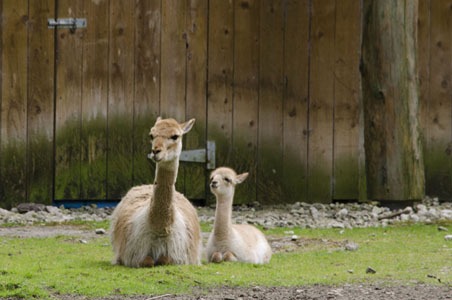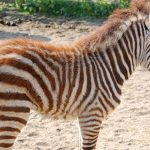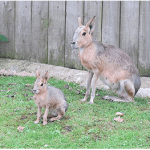An exciting time for proud parents as baby vicuna born

Flamingo Land is pleased to announce the birth of a baby vicuna (cria) born on Sunday 29th June. The cria is fit and healthy and was standing and walking around an hour after birth. Its sex is still unknown but the zoo keepers should be able to find out within the next few days.
Both mum and dad, Holly and Bailey, are doing an excellent job at looking after and protecting their new addition. This is the pair’s first successful offspring therefore it is an exciting time for them and the zoo staff!
Holly and Bailey will both be 6 years old this summer and have been residents at Flamingo Land for 4 and a half years. Holly came to us from Zoo Parc in Holland and Bailey had a significantly shorter journey by coming from Twycross Zoo in UK. Their partnership was recommended as they are involved in a European endangered species programme (EEP) which manages individuals and encourages the conservation and breeding of them. The vicuna used to be a common species but since the 1500s, after the Spanish conquest, their numbers were reduced to around 10,000 by the 1960s, making it one of the most threatened species in South America. This prompted conservationists to set up breeding programmes to increase their numbers and conservation areas to help protect them from poachers. This has proven to be successful as there are now over 300,000 found within South America and they are classed as being least concern by the IUCN. These efforts need to continue as vicuna are still poached for their wool and the deterioration of grasslands is another threat to them, in addition to climate change which could affect the environment and ecosystem they live in.
Vicunas belong in the camelid family along with camels, alpacas, llamas and guanacos. It is thought that the vicuna is a wild ancestor of the alpaca. They have a long neck and legs and feet which are able to grip onto rocks and gravel. They have brown fur on their backs and white on their fronts. A general group in the wild consists of a dominant male, several females and their young. The male defends two separate territories; one used for sleeping at a high altitude and a lower one for grazing on the grass during the day. The male also looks out for predators and gives out a whistling call to notify the rest of the group and helps to defend them. If they decide to flee they can reach speeds of around 50 kilometres an hour.
Lindsay Taylor – Education Officer


